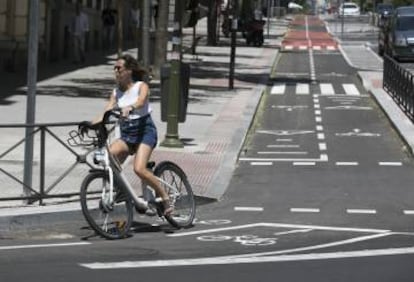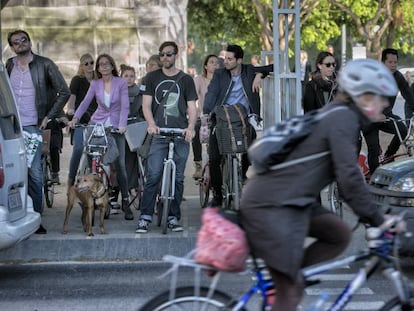I hate the bicycle lane!
Supporters and detractors of segregated infrastructure are divided over Madrid measures
Madrid has come late to the bicycle scene, and the figures show it: city trips made on two wheels still represent less than one percent of the total. How can this number be increased? Seville, the capital of Andalusia, is one example: city officials created an extensive network of segregated, connected bike lanes and the number of bike trips has since risen to 7%. But some people say that bicycles should share the same space with cars, and that two-wheel growth is not possible without increasing restrictions on private vehicles.

What should have been a technical debate, in theory at least, has morphed into a semi-philosophical confrontation between ¡°bike-laners¡± and ¡°road-sharers.¡± The recent accident involving a biker who was hit by a car on Madrid¡¯s Alcal¨¢ street has supporters and detractors of segregated lanes even angrier. Detractors are already blaming the infrastructure without waiting for the investigation to end. Meanwhile, the new bike lanes recently inaugurated by the city of Madrid have been used by supporters as ammunition for their cause.
¡°Madrid is doing the same as many other cities: developing bicycle routes that will attract new users to public lanes, not just in the downtown area but also in the outlying districts,¡± says Carlos Corral, the city¡¯s deputy director for sustainable mobility about the push to build more segregated lanes. ¡°We want people to take their bikes to university, to the city center, to work.¡±
Ciudadanos spokeswoman Bego?a Villac¨ªs calls segregated lanes ¡°an old, failed idea¡±
Bego?a Villac¨ªs, the municipal spokeswoman for the protest party Ciudadanos, embraces the shared-space theory instead, and calls the segregated lanes ¡°an old, failed idea.¡± Instead, she supports ¡°integrating bicycles into the traffic¡± arguing: ¡°Madrile?os are increasingly trained in [driver-rider] coexistence.¡±
Villac¨ªs adds that her party, unlike city officials, has talked to all existing cycling associations ¡°and they¡¯ve told us that they don¡¯t believe in this segregated lane formula. We will see a popular outcry asking for these lanes to be eliminated. ¡±
Yet 26 cycling associations, including Pedalibre, Madridlineal and Madrid en bici, have signed a document supporting the measures, which include 19 bike lanes within the two beltways that encircle the city.
Madrid, a city where traffic jams are endemic and the average speed on the M-30 ringroad is 13km/h, 80% of city space is still devoted to four-wheel transportation. Yet car trips represent fewer than 26% of journeys in the city ¨C most people walk to where they want to go, or use some other form of transportation.

During the crisis years, many cyclists accepted the shared-road system based on the theory that it was better than nothing at all. But people are now demanding safer infrastructure. A survey conducted by the consumer association OCU in 10 Spanish cities this year found that the main issues stopping people from using a bike is the traffic and the lack of bicycle lanes. ¡°Without bicycle lanes, there is no safety,¡± summed up the report.
In short, while regular cyclists and politicians may hate the bike lanes, citizens who do not typically use a bicycle ¨C and these far outnumber the two other groups ¨C feel that they need this type of infrastructure in order to feel safe. They need to see that pedalling around Madrid is not just desirable and sustainable, but also possible.
English version by Susana Urra.
Tu suscripci¨®n se est¨¢ usando en otro dispositivo
?Quieres a?adir otro usuario a tu suscripci¨®n?
Si contin¨²as leyendo en este dispositivo, no se podr¨¢ leer en el otro.
FlechaTu suscripci¨®n se est¨¢ usando en otro dispositivo y solo puedes acceder a EL PA?S desde un dispositivo a la vez.
Si quieres compartir tu cuenta, cambia tu suscripci¨®n a la modalidad Premium, as¨ª podr¨¢s a?adir otro usuario. Cada uno acceder¨¢ con su propia cuenta de email, lo que os permitir¨¢ personalizar vuestra experiencia en EL PA?S.
En el caso de no saber qui¨¦n est¨¢ usando tu cuenta, te recomendamos cambiar tu contrase?a aqu¨ª.
Si decides continuar compartiendo tu cuenta, este mensaje se mostrar¨¢ en tu dispositivo y en el de la otra persona que est¨¢ usando tu cuenta de forma indefinida, afectando a tu experiencia de lectura. Puedes consultar aqu¨ª los t¨¦rminos y condiciones de la suscripci¨®n digital.










































